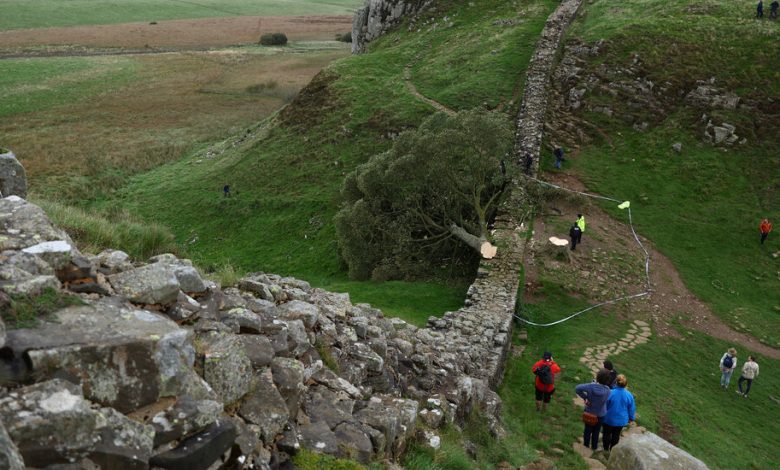A Tree Was Felled. No One Heard It. How Do You Find Out Who Did It?

Tony Gates was one of the first to hear the bad news. The chief executive of Northumberland National Park, a 400-square-mile swatch of rolling hills and wild moorland on England’s northern edge, he received a phone call early last Thursday informing him that one of the area’s most celebrated landmarks, the tree at Sycamore Gap, was no more.
At first, Mr. Gates was relatively sanguine. The tree had stood for two centuries in a dip roughly halfway along the 80-mile run of Hadrian’s Wall — the northernmost boundary of the Roman Empire at its peak, constructed to distinguish the civilization of England from the barbarism of what is now mostly Scotland.
The tree was iconic in a literal sense: Its silhouette had become a shorthand for the area as a whole, depicted on an array of locally-produced gins, beers and cookies. But it was also a living thing, and, as such, it was “finite,” Mr. Gates said.
The previous night, Storm Agnes had whipped across northern England, bringing with it 60-mile-an-hour winds. Mr. Gates assumed the tree, 70 feet tall and set in what is essentially a wind tunnel, had toppled in the storm, a sad but natural end. He dispatched a trail ranger to assess the damage.
It was when the ranger reported back that everything changed. The tree had not been brought down by natural forces. The cut was too clean. The trunk had been daubed with white paint. An incision known as a wedge cut had been made, designed to guide the tree’s fall. The ranger was unequivocal. “He said it was gone,” Mr. Gates remembered. “Someone had spoiled it.”
What followed, he said, was “overwhelming.” For many, both in the northeast of England and much farther afield, the loss of the tree represented what Mr. Gates called a “personal loss.”
“A lot of people felt a personal connection to it,” he added.
Many more, though, felt the pull of a pair of intertwined, irresistible mysteries. If a tree is felled and nobody is around to hear it, how does anyone begin to find out who was responsible? And, almost more intriguing still: What possible motive could there be for attacking a tree?
A few hours after the ranger’s report, when Mr. Gates arrived at the Sill, a glass-fronted information center a mile or so from where the tree had stood, he found visitors in tears.
Now, children’s portraits of the tree line the walls of the swiftly-established “celebration room” dedicated to the tree. So many people wanted to offer tributes that the park authority set up a book of remembrance; it quickly filled up with memories and poems and messages of thanks. Those who could not make it in person paid their respects however they could. The Sill received phone calls from across the world.
At Herding Hill Farm, a campsite a couple of miles down the road, the owners, Phil and Sue Humphreys, received somewhere in the region of 3,500 comments about the tree on their Facebook page, messages from locals but also strangers in South Africa, the United States and Australia. “And that’s just us,” Mr. Humphreys said. “There were so many that after a while we stopped counting.”
That the tree’s demise elicited such an outpouring of emotion, he said, was not a surprise. “We know of people who have scattered ashes there, and we’ve had guests who proposed there,” Mr. Humphreys said.
It was, Mr. Gates said, the sort of place where “people created memories. It was a punctuation mark on the landscape,” he said. “It was part of the natural heritage of this part of the world.”
Over the days that followed, that sadness mutated. “There’s a lot more genuine anger now,” said Matt Brown, the chief brewer at the Twice Brewed Brewing Company, which occupies the land next to the Sill. Its best-selling product, naturally, is an ale called Sycamore Gap. “You see the fury online, and you just presume that’s the internet being an empathy filter. But people are saying those things out loud now, too, and they’re completely serious.”
Few of them believe that all of this is the result of a spontaneous act of wanton destruction. Felling a tree of that scale requires considerable expertise at any time, let alone in the middle of the night and in the middle of a storm.
Besides, although the tree was relatively easily accessible from both east and west, it was still at least a 20-minute walk from the nearest parking lot. “You would have time to think about whether you really wanted to do it,” said Mr. Brown.
Northumbria Police, the local law enforcement agency, reached the same conclusion, describing the tree’s felling as “a deliberate act of vandalism,” one that had not only destroyed a beloved landmark but also damaged Hadrian’s Wall, a UNESCO World Heritage site.
Two people were swiftly arrested in connection with the incident: a 16-year-old boy and Walter Renwick, a farmer in his 60s. Both have been released on bail as the police continue to carry out “a range of inquiries.” Even before his arrest, Mr. Renwick had protested his innocence.
“I am a former lumberjack, and I have just been kicked off my property, so I can see why people have pointed the finger,” Mr. Renwick told The Sun. “It’s very sad. It’s an iconic tree. But it was the perfect night to do it. There was a full moon, so it would have been well lit and the wind would have meant there was barely any sound.”
That is the complication, of course, that a crime committed in a remote, sparsely-populated area presents to officers. The Northumbria Police has insisted that the public has been “helpful” in providing information, and investigators have collected whatever nearby CCTV footage they can. Officers are “using every tactic at our disposal,” the police said, including forensic analysis to search for sawdust from the tree.
In discovering the identity of the culprit, the hope is that the police will be able to shed some light on the person’s motivation. “I’d love to know why someone would do that specifically,” said Guy Lochner, the owner of Cragside Riding Stables, on the outskirts of Bardon Mill, the nearest village to the site. He is a professed fan of police procedural dramas. “Who would you have to be angry with, and for what reason, to make you think that was the natural response?”
Whatever the reason, and whoever was behind it, there is little doubt that the person underestimated the response, both among those for whom the tree was a symbol of where they are from and those for whom it was a place to go.
“I don’t think they can have anticipated the reaction,” said Mr. Brown, the brewer. “I think they probably thought it was just a tree in a dip.”



